Don Quixote
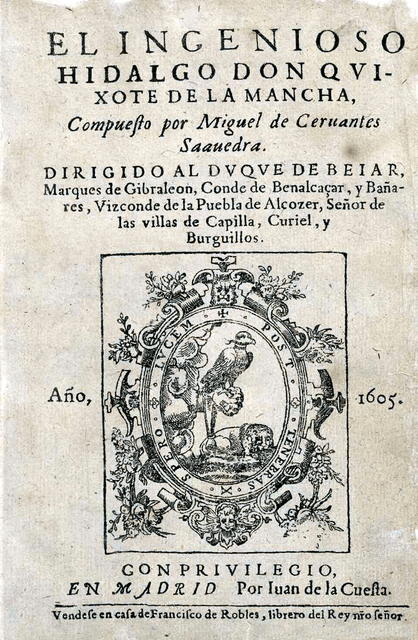
Don Quixote

| Author | Miguel de Cervantes |
|---|---|
| Original title | |
| Illustrator | Anonymous |
| Cover artist | Anonymous |
| Country | Spain |
| Language | Early Modern Spanish |
| Genre | Novel |
| Publisher | Francisco de Robles |
Publication date | 1605 (Part One) 1615 (Part Two) |
Published in English | 1612 (Part One) 1620 (Part Two) |
| Media type | |
| Pages | 863 |
Dewey Decimal | 863 |
| LC Class | PQ6323 |
The Ingenious Gentleman Don Quixote of La Mancha (Modern Spanish: El ingenioso hidalgo Don Quijote de la Mancha, pronounced [el iŋxeˈnjoso iˈðalɣo ðoŋ kiˈxote ðe la ˈmantʃa]), or just Don Quixote (/ˌdɒn kiːˈhoʊti/, US: /-teɪ/,[1] Spanish: [doŋ kiˈxote] (listen)), is a Spanish novel by Miguel de Cervantes. Published in two parts, in 1605 and 1615, Don Quixote is the most influential work of literature from the Spanish Golden Age and the entire Spanish literary canon. A founding work of Western literature, it is often labeled "the first modern novel"[2] and is sometimes considered the best literary work ever written.[3][4]
The plot revolves around the adventures of a noble (hidalgo) from La Mancha named Alonso Quixano, who reads so many chivalric romances that he loses his mind and decides to become a knight-errant (caballero andante) to revive chivalry and serve his nation, under the name Don Quixote de la Mancha. He recruits a simple farmer, Sancho Panza, as his squire, who often employs a unique, earthy wit in dealing with Don Quixote's rhetorical monologues on knighthood, already considered old-fashioned at the time. Don Quixote, in the first part of the book, does not see the world for what it is and prefers to imagine that he is living out a knightly story.
The book had a major influence on the literary community, as evidenced by direct references in Alexandre Dumas' The Three Musketeers (1844), Mark Twain's Adventures of Huckleberry Finn (1884), and Edmond Rostand's Cyrano de Bergerac (1897), as well as the word quixotic and the epithet Lothario; the latter refers to a character in "El curioso impertinente" ("The Impertinently Curious Man"), an intercalated story that appears in Part One, chapters 33–35. The 19th-century German philosopher Arthur Schopenhauer cited Don Quixote as one of the four greatest novels ever written, along with Tristram Shandy, La Nouvelle Héloïse, and Wilhelm Meisters Lehrjahre.[5]
When first published, Don Quixote was usually interpreted as a comic novel. After the French Revolution, it was better known for its central ethic that individuals can be right while society is quite wrong and seen as disenchanting. In the 19th century, it was seen as a social commentary, but no one could easily tell "whose side Cervantes was on". Many critics came to view the work as a tragedy in which Don Quixote's idealism and nobility are viewed by the post-chivalric world as insane, and are defeated and rendered useless by common reality. By the 20th century, the novel had come to occupy a canonical space as one of the foundations of modern literature.
| Author | Miguel de Cervantes |
|---|---|
| Original title | |
| Illustrator | Anonymous |
| Cover artist | Anonymous |
| Country | Spain |
| Language | Early Modern Spanish |
| Genre | Novel |
| Publisher | Francisco de Robles |
Publication date | 1605 (Part One) 1615 (Part Two) |
Published in English | 1612 (Part One) 1620 (Part Two) |
| Media type | |
| Pages | 863 |
Dewey Decimal | 863 |
| LC Class | PQ6323 |
Summary
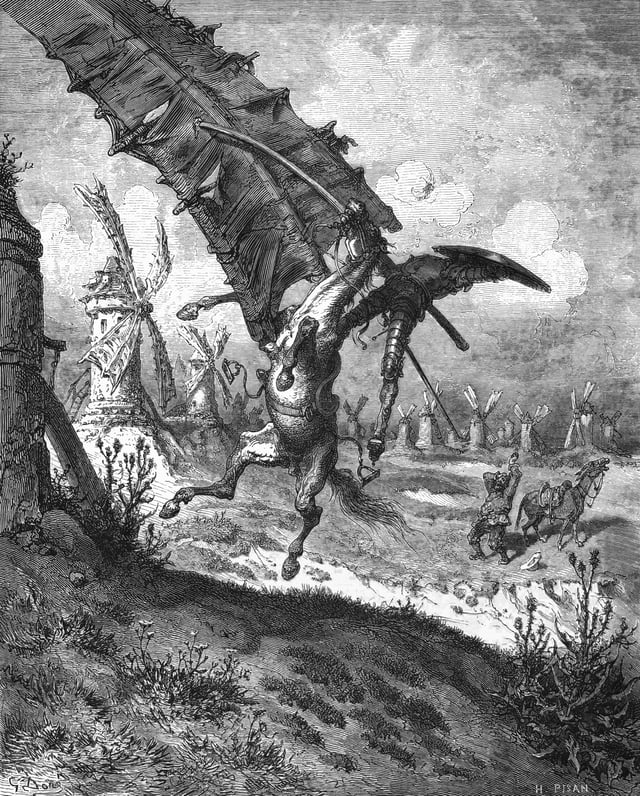
Illustration by Gustave Doré depicting the famous windmill scene
Cervantes wrote that the first chapters were taken from "the archives of La Mancha", and the rest were translated from an Arabic text by the Moorish author Cide Hamete Benengeli. This metafictional trick appears to give a greater credibility to the text, implying that Don Quixote is a real character and that the events related truly occurred several decades prior to the recording of this account. However, it was also common practice in that era for fictional works to make some pretense of being factual, such as the common opening line of fairy tales "Once upon a time in a land far away...".
In the course of their travels, the protagonists meet innkeepers, prostitutes, goat-herders, soldiers, priests, escaped convicts and scorned lovers. The aforementioned characters sometimes tell tales that incorporate events from the real world, like the conquest of the Kingdom of Maynila or battles in the Eighty Years' War.[6] Their encounters are magnified by Don Quixote's imagination into chivalrous quests. Don Quixote's tendency to intervene violently in matters irrelevant to himself, and his habit of not paying debts, result in privations, injuries, and humiliations (with Sancho often the victim). Finally, Don Quixote is persuaded to return to his home village. The narrator hints that there was a third quest, but says that records of it have been lost.
Part 1
The First Sally (Chapters 1–5)
Alonso Quixano, the protagonist of the novel (though he is not given this name until much later in the book), is a Hidalgo (member of the lesser Spanish nobility), nearing 50 years of age, living in an unnamed section of La Mancha with his niece and housekeeper, as well as a boy who is never heard of again after the first chapter. Although Quixano is usually a rational man, in keeping with the humoral physiology theory of the time, not sleeping adequately—because he was reading—has caused his brain to dry; Quixano's temperament is thus choleric, the hot and dry humor. As a result, he is easily given to anger[7] and believes every word of these fictional books of chivalry to be true.
Imitating the protagonists of these books, he decides to become a knight errant in search of adventure. To these ends, he dons an old suit of armor, renames himself "Don Quixote", names his exhausted horse "Rocinante", and designates Aldonza Lorenzo, a neighboring farm girl, as his lady love, renaming her Dulcinea del Toboso, while she knows nothing of this. Expecting to become famous quickly, he arrives at an inn, which he believes to be a castle; calls the prostitutes he meets "ladies" (doncellas); and demands that the innkeeper, whom he takes to be the lord of the castle, dub him a knight. He spends the night holding vigil over his armor and becomes involved in a fight with muleteers who try to remove his armor from the horse trough so that they can water their mules. In a pretended ceremony, the innkeeper dubs him a knight to be rid of him and sends him on his way.
Don Quixote next "frees" a young boy named Andres who is tied to a tree and beaten by his master, and makes his master swear to treat the boy fairly; but the boy's beating is continued (and in fact redoubled) as soon as Quixote leaves. Don Quixote then encounters traders from Toledo, who "insult" the imaginary Dulcinea. He attacks them, only to be severely beaten and left on the side of the road, and is returned to his home by a neighboring peasant.
Destruction of Don Quixote's library (Chapters 6 and 7)
While Don Quixote is unconscious in his bed, his niece, the housekeeper, the parish curate and the local barber burn most of his chivalric and other books. A large part of this section consists of the priest deciding which books deserve to be burned and which to be saved. It is a scene of high comedy: If the books are so bad for morality, how does the priest know them well enough to describe every naughty scene? Even so, this gives an occasion for many comments on books Cervantes himself liked and disliked. For example, Cervantes' own pastoral novel La Galatea is saved, while the rather unbelievable romance Felixmarte de Hyrcania is burned. After the books are dealt with, they seal up the room which contained the library, later telling Don Quixote that it was the action of a wizard (encantador).
The Second Sally
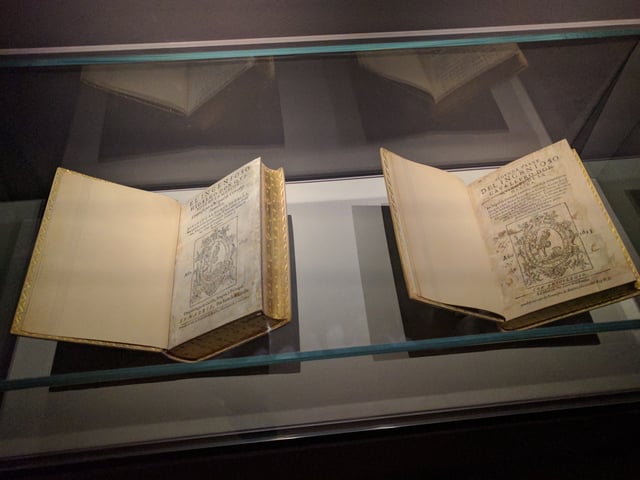
First editions of the first and second part
After a short period of feigning health, Don Quixote requests his neighbour, Sancho Panza, to be his squire, promising him a petty governorship (ínsula). Sancho is a poor and simple farmer but more practical than the head-in-the-clouds Don Quixote and agrees to the offer, sneaking away with Don Quixote in the early dawn. It is here that their famous adventures begin, starting with Don Quixote's attack on windmills that he believes to be ferocious giants.
The two next encounter two Benedictine friars travelling on the road ahead of a lady in a carriage. The friars are not travelling with the lady, but happen to be travelling on the same road. Don Quixote takes the friars to be enchanters who hold the lady captive, knocks a friar from his horse, and is challenged by an armed Basque traveling with the company. As he has no shield, the Basque uses a pillow from the carriage to protect himself, which saves him when Don Quixote strikes him. Cervantes chooses this point, in the middle of the battle, to say that his source ends here. Soon, however, he resumes Don Quixote's adventures after a story about finding Arabic notebooks containing the rest of the story by Cid Hamet Ben Engeli. The combat ends with the lady leaving her carriage and commanding those traveling with her to "surrender" to Don Quixote.
The Pastoral Peregrinations (Chapters 11–15)
Sancho and Don Quixote fall in with a group of goat herders. Don Quixote tells Sancho and the goat herders about the "Golden Age" of man, in which property does not exist and men live in peace. The goatherders invite the Knight and Sancho to the funeral of Grisóstomo, a former student who left his studies to become a shepherd after reading pastoral novels (paralleling Don Quixote's decision to become a knight), seeking the shepherdess Marcela. At the funeral Marcela appears, vindicating herself from the bitter verses written about her by Grisóstomo, and claiming her own autonomy and freedom from expectations put on her by pastoral clichés. She disappears into the woods, and Don Quixote and Sancho follow. Ultimately giving up, the two dismount by a pond to rest. Some Galicians arrive to water their ponies, and Rocinante (Don Quixote's horse) attempts to mate with the ponies. The Galicians hit Rocinante with clubs to dissuade him, whereupon Don Quixote tries to defend Rocinante. The Galicians beat Don Quixote and Sancho, leaving them in great pain.
The inn (Chapters 16–17)
After escaping the musketeers, Don Quixote and Sancho ride to a nearby inn. Once again, Don Quixote imagines the inn is a castle, although Sancho is not quite convinced. Don Quixote is given a bed in a former hayloft, and Sancho sleeps on the rug next to the bed; they share the loft with a muleteer. When night comes, Don Quixote imagines the servant girl at the inn, Helen, to be a beautiful princess, and makes her sit on his bed with him, scaring her. Seeing what is happening, the muleteer attacks Don Quixote, breaking the fragile bed and leading to a large and chaotic fight in which Don Quixote and Sancho are once again badly hurt. Don Quixote's explanation for everything is that they fought with an enchanted Moor. He also believes that he can cure their wounds with a mixture he calls "the balm of Fierabras", which only makes them sick. Don Quixote and Sancho decide to leave the inn, but Quixote, following the example of the fictional knights, leaves without paying. Sancho, however, remains and ends up wrapped in a blanket and tossed up in the air (blanketed) by several mischievous guests at the inn, something that is often mentioned over the rest of the novel. After his release, he and Don Quixote continue their travels.
The galley slaves and Cardenio (Chapters 19–24)
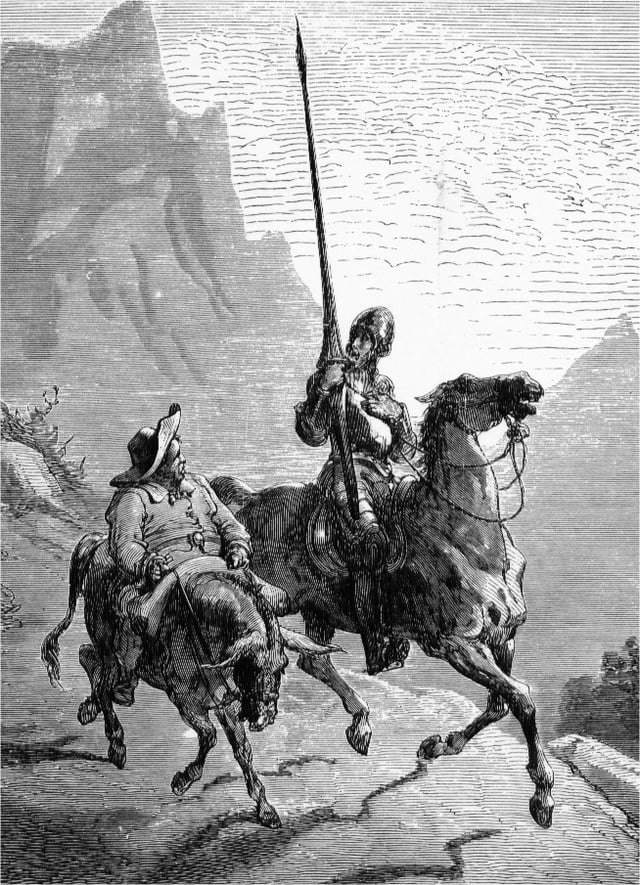
Don Quixote de la Mancha and Sancho Panza, 1863, by Gustave Doré.
After Don Quixote has adventures involving a dead body, a helmet, and freeing a group of galley slaves, he and Sancho wander into the Sierra Morena and there encounter the dejected Cardenio. Cardenio relates the first part of his story, in which he falls deeply in love with his childhood friend Lucinda, and is hired as the companion to the Duke's son, leading to his friendship with the Duke's younger son, Don Fernando. Cardenio confides in Don Fernando his love for Lucinda and the delays in their engagement, caused by Cardenio's desire to keep with tradition. After reading Cardenio's poems praising Lucinda, Don Fernando falls in love with her. Don Quixote interrupts when Cardenio suggests that his beloved may have become unfaithful after the formulaic stories of spurned lovers in chivalric novels. They get into a fight, ending with Cardenio beating all of them and walking away to the mountains.
The priest, the barber, and Dorotea (Chapters 25–31)
Quixote pines for Dulcinea, imitating Cardenio. Quixote sends Sancho to deliver a letter to Dulcinea, but instead Sancho finds the barber and priest from his village and brings them to Quixote. The priest and barber make plans to trick Don Quixote to come home. They get the help of Dorotea, a woman who has been deceived by Don Fernando with promises of love and marriage. She pretends that she is the Princess Micomicona and desperate to get Quixote's help. Quixote runs into Andres, who insults his incompetence.
Return to the inn (Chapters 32–42)
The group returns to the previous inn where the priest tells the story of Anselmo (The Impertinentely Curious Man) while Quixote, sleepwalking, battles with wineskins that he takes to be the giant who stole the princess Micomiconia's kingdom. Dorotea is reunited with Don Fernando and Cardenio with Lucinda. A captive from Moorish lands arrives and is asked to tell the story of his life. A judge arrives, and it is found that the captive is his long-lost brother, and the two are reunited.
The ending (Chapters 45–52)
An officer of the Santa Hermandad has a warrant for Quixote's arrest for freeing the galley slaves. The priest begs for the officer to have mercy on account of Quixote's insanity. The officer agrees, and Quixote is locked in a cage and made to think that it is an enchantment and that there is a prophecy of his heroic return home. While traveling, the group stops to eat and lets Quixote out of the cage; he gets into a fight with a goatherd and with a group of pilgrims, who beat him into submission, and he is finally brought home. The narrator ends the story by saying that he has found manuscripts of Quixote's further adventures.
Part 2

Illustration to The Ingenious Gentleman Don Quixote of La Mancha. Volume II.
Although the two parts are now published as a single work, Don Quixote, Part Two was a sequel published ten years after the original novel. While Part One was mostly farcical, the second half is more serious and philosophical about the theme of deception.
Part Two of Don Quixote explores the concept of a character understanding that he is written about, an idea much explored in the 20th century. As Part Two begins, it is assumed that the literate classes of Spain have all read the first part of the story. Cervantes' meta-fictional device was to make even the characters in the story familiar with the publication of Part One, as well as with an actually published, fraudulent Part Two.
The Third Sally
When strangers encounter the duo in person, they already know their famous history. A Duke and Duchess, and others, deceive Don Quixote for entertainment, setting forth a string of imagined adventures resulting in a series of practical jokes. Some of them put Don Quixote's sense of chivalry and his devotion to Dulcinea through many tests. Pressed into finding Dulcinea, Sancho brings back three ragged peasant girls and tells Don Quixote that they are Dulcinea and her ladies-in-waiting. When Don Quixote only sees the peasant girls, Sancho pretends (reversing some incidents of Part One) that their derelict appearance results from an enchantment.
Sancho later gets his comeuppance for this when, as part of one of the Duke and Duchess's pranks, the two are led to believe that the only method to release Dulcinea from her spell is for Sancho to give himself three thousand three hundred lashes. Sancho naturally resists this course of action, leading to friction with his master. Under the Duke's patronage, Sancho eventually gets a governorship, though it is false; and he proves to be a wise and practical ruler; though this ends in humiliation as well. Near the end, Don Quixote reluctantly sways towards sanity.
The lengthy untold "history" of Don Quixote's adventures in knight-errantry comes to a close after his battle with the Knight of the White Moon (a young man from Don Quixote's hometown who had previously posed as the Knight of Mirrors) on the beach in Barcelona, in which the reader finds him conquered. Bound by the rules of chivalry, Don Quixote submits to prearranged terms that the vanquished is to obey the will of the conqueror: here, it is that Don Quixote is to lay down his arms and cease his acts of chivalry for the period of one year (in which he may be cured of his madness). He and Sancho undergo one more prank by the Duke and Duchess before setting off.
Upon returning to his village, Don Quixote announces his plan to retire to the countryside as a shepherd, but his housekeeper urges him to stay at home. Soon after, he retires to his bed with a deathly illness, and later awakes from a dream, having fully recovered his sanity. Sancho tries to restore his faith, but Quixano (his proper name) only renounces his previous ambition and apologizes for the harm he has caused. He dictates his will, which includes a provision that his niece will be disinherited if she marries a man who reads books of chivalry. After Alonso Quixano dies, the author emphasizes that there are no more adventures to relate and that any further books about Don Quixote would be spurious.
Meaning
Harold Bloom says Don Quixote is the first modern novel, and that the protagonist is at war with Freud's reality principle, which accepts the necessity of dying.[8]
Edith Grossman, who wrote and published a highly acclaimed English translation of the novel in 2003, says that the book is mostly meant to move people into emotion using a systematic change of course, on the verge of both tragedy and comedy at the same time. Grossman has stated:
The question is that Quixote has multiple interpretations [...] and how do I deal with that in my translation. I'm going to answer your question by avoiding it [...] so when I first started reading the Quixote I thought it was the most tragic book in the world, and I would read it and weep [...] As I grew older [...] my skin grew thicker [...] and so when I was working on the translation I was actually sitting at my computer and laughing out loud. This is done [...] as Cervantes did it [...] by never letting the reader rest. You are never certain that you truly got it. Because as soon as you think you understand something, Cervantes introduces something that contradicts your premise.[9]
Themes
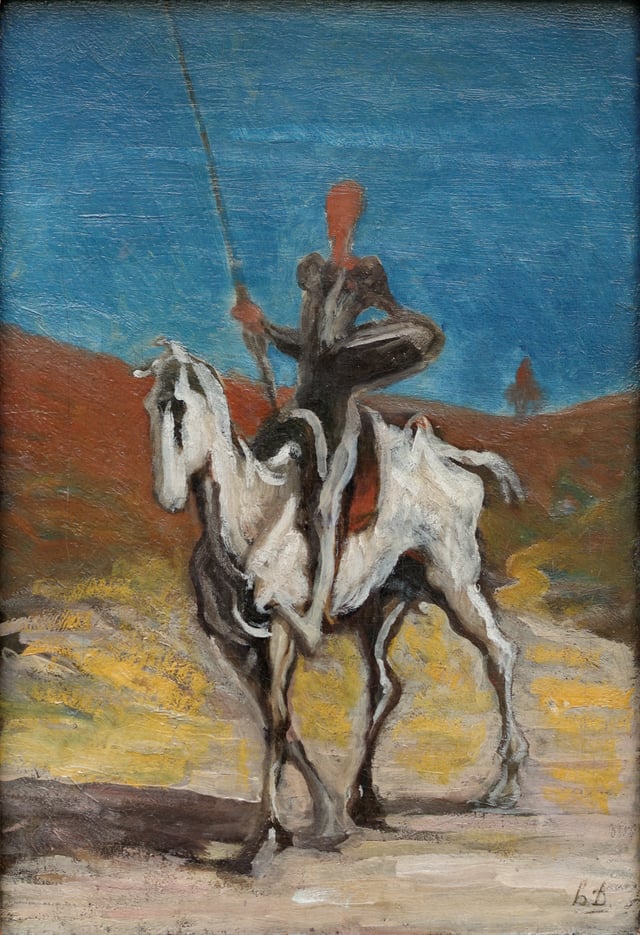
Don Quixote by Honoré Daumier (1868)
The novel's structure is episodic in form. The full title is indicative of the tale's object, as ingenioso (Spanish) means "quick with inventiveness",[10] marking the transition of modern literature from dramatic to thematic unity. The novel takes place over a long period of time, including many adventures united by common themes of the nature of reality, reading, and dialogue in general.
Although burlesque on the surface, the novel, especially in its second half, has served as an important thematic source not only in literature but also in much of art and music, inspiring works by Pablo Picasso and Richard Strauss. The contrasts between the tall, thin, fancy-struck and idealistic Quixote and the fat, squat, world-weary Panza is a motif echoed ever since the book's publication, and Don Quixote's imaginings are the butt of outrageous and cruel practical jokes in the novel.
Even faithful and simple Sancho is forced to deceive him at certain points. The novel is considered a satire of orthodoxy, veracity and even nationalism. In exploring the individualism of his characters, Cervantes helped move beyond the narrow literary conventions of the chivalric romance literature that he spoofed, which consists of straightforward retelling of a series of acts that redound to the knightly virtues of the hero. The character of Don Quixote became so well known in its time that the word quixotic was quickly adopted by many languages. Characters such as Sancho Panza and Don Quixote's steed, Rocinante, are emblems of Western literary culture. The phrase "tilting at windmills" to describe an act of attacking imaginary enemies (or an act of extreme idealism), derives from an iconic scene in the book.
It stands in a unique position between medieval chivalric romance and the modern novel. The former consist of disconnected stories featuring the same characters and settings with little exploration of the inner life of even the main character. The latter are usually focused on the psychological evolution of their characters. In Part I, Quixote imposes himself on his environment. By Part II, people know about him through "having read his adventures", and so, he needs to do less to maintain his image. By his deathbed, he has regained his sanity, and is once more "Alonso Quixano the Good".
Background
Sources
Sources for Don Quixote include the Castilian novel Amadis de Gaula, which had enjoyed great popularity throughout the 16th century. Another prominent source, which Cervantes evidently admires more, is Tirant lo Blanch, which the priest describes in Chapter VI of Quixote as "the best book in the world." (However, the sense in which it was "best" is much debated among scholars. The passage is called since the 19th century "the most difficult passage of Don Quixote".) The scene of the book burning gives us an excellent list of Cervantes' likes and dislikes about literature.
Cervantes makes a number of references to the Italian poem Orlando furioso. In chapter 10 of the first part of the novel, Don Quixote says he must take the magical helmet of Mambrino, an episode from Canto I of Orlando, and itself a reference to Matteo Maria Boiardo's Orlando innamorato.[11] The interpolated story in chapter 33 of Part four of the First Part is a retelling of a tale from Canto 43 of Orlando, regarding a man who tests the fidelity of his wife.[12]
Another important source appears to have been Apuleius's The Golden Ass, one of the earliest known novels, a picaresque from late classical antiquity. The wineskins episode near the end of the interpolated tale "The Curious Impertinent" in chapter 35 of the first part of Don Quixote is a clear reference to Apuleius, and recent scholarship suggests that the moral philosophy and the basic trajectory of Apuleius's novel are fundamental to Cervantes' program.[13] Similarly, many of both Sancho's adventures in Part II and proverbs throughout are taken from popular Spanish and Italian folklore.
Cervantes' experiences as a galley slave in Algiers also influenced Quixote.
Spurious Second Part by Avellaneda
It is not certain when Cervantes began writing Part Two of Don Quixote, but he had probably not proceeded much further than Chapter LIX by late July 1614. About September, however, a spurious Part Two, entitled Second Volume of the Ingenious Gentleman Don Quixote of La Mancha: by the Licenciado (doctorate) Alonso Fernández de Avellaneda, of Tordesillas, was published in Tarragona by an unidentified Aragonese who was an admirer of Lope de Vega, rival of Cervantes.[14] It was translated into English by William Augustus Yardley, Esquire in two volumes in 1784.
Some modern scholars suggest that Don Quixote's fictional encounter with Avellaneda in Chapter 59 of Part II should not be taken as the date that Cervantes encountered it, which may have been much earlier.
Avellaneda's identity has been the subject of many theories, but there is no consensus as to who he was. In its prologue, the author gratuitously insulted Cervantes, who not surprisingly took offense and responded; the last half of Chapter LIX and most of the following chapters of Cervantes' Segunda Parte lend some insight into the effects upon him; Cervantes manages to work in some subtle digs at Avellaneda's own work, and in his preface to Part II, comes very near to criticizing Avellaneda directly.
In his introduction to The Portable Cervantes, Samuel Putnam, a noted translator of Cervantes' novel, calls Avellaneda's version "one of the most disgraceful performances in history".[15]
The second part of Cervantes' Don Quixote, finished as a direct result of the Avellaneda book, has come to be regarded by some literary critics[16] as superior to the first part, because of its greater depth of characterization, its discussions, mostly between Quixote and Sancho, on diverse subjects, and its philosophical insights.
Other stories
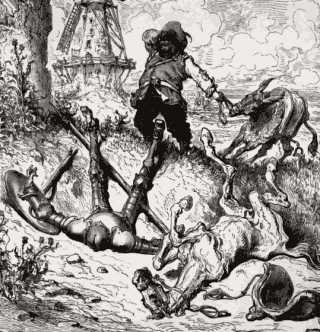
Don Quixote, his horse Rocinante and his squire Sancho Panza after an unsuccessful attack on a windmill. By Gustave Doré.
Don Quixote, Part One contains a number of stories which do not directly involve the two main characters, but which are narrated by some of the picaresque figures encountered by the Don and Sancho during their travels. The longest and best known of these is "El Curioso Impertinente" (the impertinently curious man), found in Part One, Book Four. This story, read to a group of travelers at an inn, tells of a Florentine nobleman, Anselmo, who becomes obsessed with testing his wife's fidelity, and talks his close friend Lothario into attempting to seduce her, with disastrous results for all.
In Part Two, the author acknowledges the criticism of his digressions in Part One and promises to concentrate the narrative on the central characters (although at one point he laments that his narrative muse has been constrained in this manner). Nevertheless, "Part Two" contains several back narratives related by peripheral characters.
Several abridged editions have been published which delete some or all of the extra tales in order to concentrate on the central narrative.[17]
Style
Spelling and pronunciation
Cervantes wrote his work in early modern Spanish, heavily borrowing from Old Castilian, the medieval form of the language. The language of Don Quixote, although still containing archaisms, is far more understandable to modern Spanish readers than is, for instance, the completely medieval Spanish of the Poema de mio Cid, a kind of Spanish that is as different from Cervantes' language as Middle English is from Modern English. The Old Castilian language was also used to show the higher class that came with being a knight errant.
In Don Quixote, there are basically two different types of Castilian: Old Castilian is spoken only by Don Quixote, while the rest of the roles speak a contemporary (late 16th century) version of Spanish. The Old Castilian of Don Quixote is a humoristic resource – he copies the language spoken in the chivalric books that made him mad; and many times, when he talks nobody is able to understand him because his language is too old. This humorous effect is more difficult to see nowadays because the reader must be able to distinguish the two old versions of the language, but when the book was published it was much celebrated. (English translations can get some sense of the effect by having Don Quixote use King James Bible or Shakespearian English, or even Middle English.)
In Old Castilian, the letter x represented the sound written sh in modern English, so the name was originally pronounced [kiˈʃote]. However, as Old Castilian evolved towards modern Spanish, a sound change caused it to be pronounced with a voiceless velar fricative sound (like the Scottish or German ch), and today the Spanish pronunciation of "Quixote" is [kiˈxote]. The original pronunciation is reflected in languages such as Asturian, Leonese, Galician, Catalan, Italian, Portuguese, and French, where it is pronounced with a "sh" or "ch" sound; the French opera Don Quichotte is one of the best-known modern examples of this pronunciation.
Today, English speakers generally attempt something close to the modern Spanish pronunciation of Quixote (Quijote), as /kiːˈhoʊti/,[1] although the traditional English spelling-based pronunciation with the value of the letter x in modern English is still sometimes used, resulting in /ˈkwɪksət/ or /ˈkwɪksoʊt/. In Australian English, the preferred pronunciation amongst members of the educated classes was /ˈkwɪksət/ until well into the 1970s, as part of a tendency for the upper class to "anglicise its borrowing ruthlessly".[18] The traditional English rendering is preserved in the pronunciation of the adjectival form quixotic, i.e., /kwɪkˈsɒtɪk/,[19][20] defined by Merriam-Webster as the foolishly impractical pursuit of ideals, typically marked by rash and lofty romanticism.[21]
Setting
Cervantes' story takes place on the plains of La Mancha, specifically the comarca of Campo de Montiel.
En un lugar de La Mancha, de cuyo nombre no quiero acordarme, no ha mucho tiempo que vivía un hidalgo de los de lanza en astillero, adarga antigua, rocín flaco y galgo corredor.(Somewhere in La Mancha, in a place whose name I do not care to remember, a gentleman lived not long ago, one of those who has a lance and ancient shield on a shelf and keeps a skinny nag and a greyhound for racing.)— Miguel de Cervantes, Don Quixote, Volume I, Chapter I (translated by Edith Grossman)
The story also takes place in El Toboso where Don Quixote goes to seek Dulcinea's blessings. The location of the village to which Cervantes alludes in the opening sentence of Don Quixote has been the subject of debate since its publication over four centuries ago. Indeed, Cervantes deliberately omits the name of the village, giving an explanation in the final chapter:
Such was the end of the Ingenious Gentleman of La Mancha, whose village Cide Hamete would not indicate precisely, in order to leave all the towns and villages of La Mancha to contend among themselves for the right to adopt him and claim him as a son, as the seven cities of Greece contended for Homer.— Miguel de Cervantes, Don Quixote, Volume II, Chapter 74
In 2004, a multidisciplinary team of academics from Complutense University, led by Francisco Parra Luna, Manuel Fernández Nieto, and Santiago Petschen Verdaguer, deduced that the village was that of Villanueva de los Infantes.[22] Their findings were published in a paper titled "'El Quijote' como un sistema de distancias/tiempos: hacia la localización del lugar de la Mancha", which was later published as a book: El enigma resuelto del Quijote. The result was replicated in two subsequent investigations: "La determinación del lugar de la Mancha como problema estadístico" and "The Kinematics of the Quixote and the Identity of the 'Place in La Mancha'".[23][24]
Researchers Isabel Sanchez Duque and Francisco Javier Escudero have found relevant information regarding the possible sources of inspiration of Cervantes for writing Don Quixote. Cervantes was friend of the family Villaseñor, which was involved in a combat with Francisco de Acuña. Both sides combated disguised as medieval knights in the road from El Toboso to Miguel Esteban in 1581. They also found a person called Rodrigo Quijada, who bought the title of nobility of "hidalgo", and created diverse conflicts with the help of a squire.[25][26]
Language
Because of its widespread influence, Don Quixote also helped cement the modern Spanish language. The opening sentence of the book created a classic Spanish cliché with the phrase "de cuyo nombre no quiero acordarme" ("whose name I do not wish to recall"): "En un lugar de la Mancha, de cuyo nombre no quiero acordarme, no hace mucho tiempo que vivía un hidalgo de los de lanza en astillero, adarga antigua, rocín flaco y galgo corredor." ("In a village of La Mancha, whose name I do not wish to recall, there lived, not very long ago, one of those gentlemen with a lance in the lance-rack, an ancient shield, a skinny old horse, and a fast greyhound.")
The novel's farcical elements make use of punning and similar verbal playfulness. Character-naming in Don Quixote makes ample figural use of contradiction, inversion, and irony, such as the names Rocinante[27] (a reversal) and Dulcinea (an allusion to illusion), and the word quixote itself, possibly a pun on quijada (jaw) but certainly cuixot (Catalan: thighs), a reference to a horse's rump.[28]
As a military term, the word quijote refers to cuisses, part of a full suit of plate armour protecting the thighs. The Spanish suffix -ote denotes the augmentative—for example, grande means large, but grandote means extra large. Following this example, Quixote would suggest 'The Great Quijano', a play on words that makes much sense in light of the character's delusions of grandeur.
La Mancha is a region of Spain, but mancha (Spanish word) means spot, mark, stain. Translators such as John Ormsby have declared La Mancha to be one of the most desertlike, unremarkable regions of Spain, the least romantic and fanciful place that one would imagine as the home of a courageous knight.
Publication

Illustration to Don Quixote de la Mancha by Miguel de Cervantes (the edition translated by Charles Jarvis)
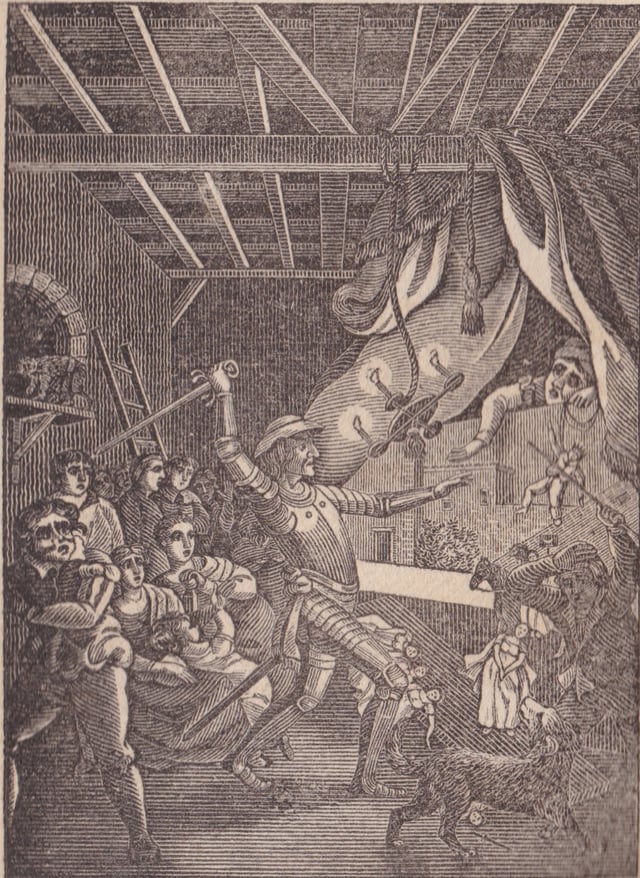
Don Quixote. Close up of Illustration.

Bronze statues of Don Quixote and Sancho Panza, at the Plaza de España in Madrid.
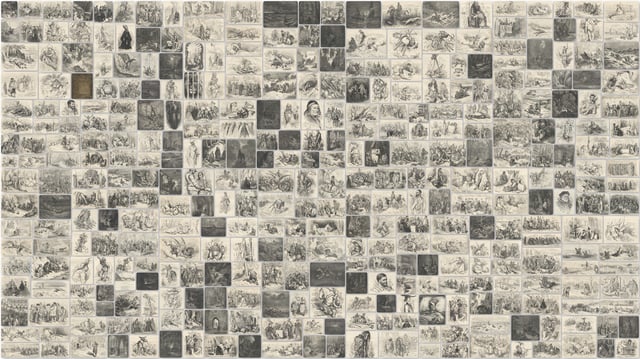
Collage of the engravings of The Adventures of Don Quixote by Gustave Doré
In July 1604, Cervantes sold the rights of El ingenioso hidalgo don Quixote de la Mancha (known as Don Quixote, Part I) to the publisher-bookseller Francisco de Robles for an unknown sum.[29] License to publish was granted in September, the printing was finished in December, and the book came out on 16 January 1605.[30][31]
The novel was an immediate success. The majority of the 400 copies of the first edition were sent to the New World, with the publisher hoping to get a better price in the Americas.[32] Although most of them disappeared in a shipwreck near La Havana, approximately 70 copies reached Lima, from where they were sent to Cuzco in the heart of the defunct Inca Empire.[32]
No sooner was it in the hands of the public than preparations were made to issue derivative (pirated) editions. Don Quixote had been growing in favour, and its author's name was now known beyond the Pyrenees. By August 1605, there were two Madrid editions, two published in Lisbon, and one in Valencia. Publisher Francisco de Robles secured additional copyrights for Aragon and Portugal for a second edition.[33]
Sale of these publishing rights deprived Cervantes of further financial profit on Part One. In 1607, an edition was printed in Brussels. Robles, the Madrid publisher, found it necessary to meet demand with a third edition, a seventh publication in all, in 1608. Popularity of the book in Italy was such that a Milan bookseller issued an Italian edition in 1610. Yet another Brussels edition was called for in 1611.[31] Since then, numerous editions have been released and in total, the novel is believed to have sold more than 500 million copies worldwide.[34] The work has been produced in numerous editions and languages, the Cervantes Collection, at the State Library of New South Wales includes over 1,100 editions. These were collected, by Dr Ben Haneman, over a period of thirty years.[35]
In 1613, Cervantes published the Novelas Ejemplares, dedicated to the Maecenas of the day, the Conde de Lemos. Eight and a half years after Part One had appeared came the first hint of a forthcoming Segunda Parte (Part Two). "You shall see shortly," Cervantes says, "the further exploits of Don Quixote and humours of Sancho Panza."[36] Don Quixote, Part Two, published by the same press as its predecessor, appeared late in 1615, and quickly reprinted in Brussels and Valencia (1616) and Lisbon (1617). Parts One and Two were published as one edition in Barcelona in 1617. Historically, Cervantes' work has been said to have "smiled Spain's chivalry away", suggesting that Don Quixote as a chivalric satire contributed to the demise of Spanish Chivalry.[37]
English editions in translation
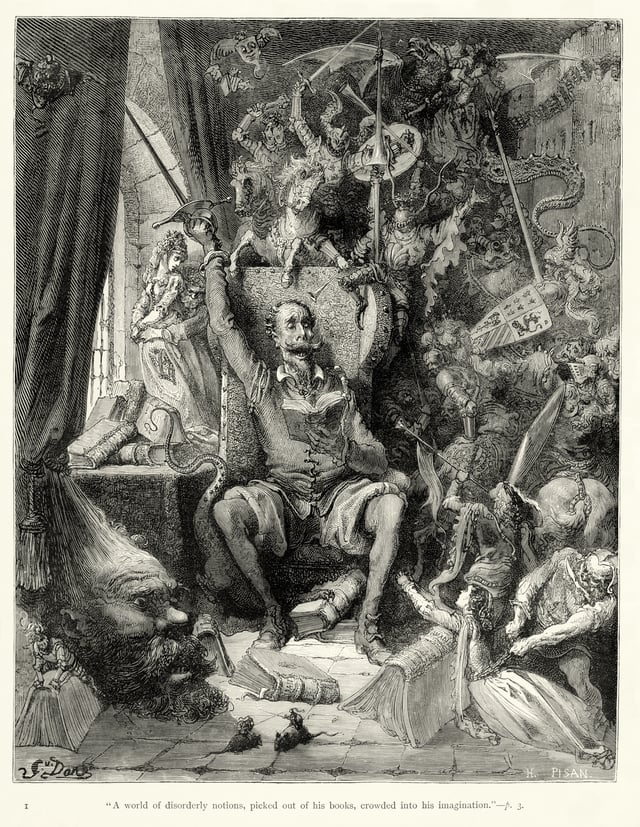
Don Quixote goes mad from his reading of books of chivalry. Engraving by Gustave Doré.
There are many translations of the book, and it has been adapted many times in shortened versions. Many derivative editions were also written at the time, as was the custom of envious or unscrupulous writers. Seven years after the Parte Primera appeared, Don Quixote had been translated into French, German, Italian, and English, with the first French translation of 'Part II' appearing in 1618, and the first English translation in 1620. One abridged adaptation, authored by Agustín Sánchez, runs slightly over 150 pages, cutting away about 750 pages.[38]
Thomas Shelton's English translation of the First Part appeared in 1612 while Cervantes was still alive, although there is no evidence that Shelton had met the author. Although Shelton's version is cherished by some, according to John Ormsby and Samuel Putnam, it was far from satisfactory as a carrying over of Cervantes' text.[33] Shelton's translation of the novel's Second Part appeared in 1620.
Near the end of the 17th century, John Phillips, a nephew of poet John Milton, published what Putnam considered the worst English translation. The translation, as literary critics claim, was not based on Cervantes' text but mostly upon a French work by Filleau de Saint-Martin and upon notes which Thomas Shelton had written.
Around 1700, a version by Pierre Antoine Motteux appeared. Motteux's translation enjoyed lasting popularity; it was reprinted as the Modern Library Series edition of the novel until recent times.[39] Nonetheless, future translators would find much to fault in Motteux's version: Samuel Putnam criticized "the prevailing slapstick quality of this work, especially where Sancho Panza is involved, the obtrusion of the obscene where it is found in the original, and the slurring of difficulties through omissions or expanding upon the text". John Ormsby considered Motteux's version "worse than worthless", and denounced its "infusion of Cockney flippancy and facetiousness" into the original.[40]
The proverb 'The proof of the pudding is in the eating' is widely attributed to Cervantes. The Spanish word for pudding, 'budín', however, doesn't appear in the original text but premieres in the Motteux translation.[41] In Smolletts translation of 1755, he notes that the original text reads literally "you will see when the eggs are fried" meaning 'time will tell'.[42]
A translation by Captain John Stevens, which revised Thomas Shelton's version, also appeared in 1700, but its publication was overshadowed by the simultaneous release of Motteux's translation.[39]
In 1742, the Charles Jervas translation appeared, posthumously. Through a printer's error, it came to be known, and is still known, as "the Jarvis translation". It was the most scholarly and accurate English translation of the novel up to that time, but future translator John Ormsby points out in his own introduction to the novel that the Jarvis translation has been criticized as being too stiff. Nevertheless, it became the most frequently reprinted translation of the novel until about 1885. Another 18th-century translation into English was that of Tobias Smollett, himself a novelist, first published in 1755. Like the Jarvis translation, it continues to be reprinted today.
A translation by Alexander James Duffield appeared in 1881 and another by Henry Edward Watts in 1888. Most modern translators take as their model the 1885 translation by John Ormsby.
An expurgated children's version, under the title The Story of Don Quixote, was published in 1922 (available on Project Gutenberg). It leaves out the risqué sections as well as chapters that young readers might consider dull, and embellishes a great deal on Cervantes' original text. The title page actually gives credit to the two editors as if they were the authors, and omits any mention of Cervantes.[43]
The most widely read English-language translations of the mid-20th century are by Samuel Putnam (1949), J. M. Cohen (1950; Penguin Classics), and Walter Starkie (1957). The last English translation of the novel in the 20th century was by Burton Raffel, published in 1996. The 21st century has already seen five new translations of the novel into English. The first is by John D. Rutherford and the second by Edith Grossman. Reviewing the novel in the New York Times, Carlos Fuentes called Grossman's translation a "major literary achievement"[44] and another called it the "most transparent and least impeded among more than a dozen English translations going back to the 17th century."[45]
In 2005, the year of the novel's 400th anniversary, Tom Lathrop published a new English translation of the novel, based on a lifetime of specialized study of the novel and its history.[46] The fourth translation of the 21st century was released in 2006 by former university librarian James H Montgomery, 26 years after he had begun it, in an attempt to "recreate the sense of the original as closely as possible, though not at the expense of Cervantes' literary style."[47]
In 2011, another translation by Gerald J. Davis appeared.[48] It is the latest and the fifth translation of the 21st century.
Tilting at windmills
Tilting at windmills is an English idiom that means attacking imaginary enemies. The expression is derived from Don Quixote, and the word "tilt" in this context comes from jousting.
The phrase is sometimes used to describe either confrontations where adversaries are incorrectly perceived, or courses of action that are based on misinterpreted or misapplied heroic, romantic, or idealistic justifications. It may also connote an importune, unfounded, and vain effort against adversaries real or imagined.[49]
List of English translations
Reviewing the English translations as a whole, Daniel Eisenberg stated that there is no one translation ideal for every purpose, but expressed a preference for those of Putnam and the revision of Ormsby's translation by Douglas and Jones.[50]
Thomas Shelton (1612 & 1620).
John Phillips (1687) – the nephew of John Milton
Captain John Stevens (1700) (revision of Thomas Shelton)
Pierre Antoine Motteux (1700)
Ned Ward (1700) – (The) Life & Notable Adventures of Don Quixote merrily translated into Hudibrastic Verse
John Ozell (1719) (revision of Pierre Antoine Motteux)
Charles Jervas (1742)
Tobias Smollett (1755) (revision of Charles Jervas)
George Kelly (1769) (considered as another revision of Pierre Antoine Motteux)
Charles Henry Wilmot (1774)
Mary Smirke with engravings by Robert Smirke (1818)
Alexander James Duffield (1881)
John Ormsby (1885) (widely available, not always in its entirety on the Internet. The best text in pdf format is: Don Quixote [58] )
Henry Edward Watts (1888)
Robinson Smith (1910)
Samuel Putnam (1949)
J. M. Cohen (1950)
Walter Starkie (1964)
Joseph Ramon Jones and Kenneth Douglas – W. W. Norton & Co.; Revised edition, 1022 pages (14 October 1981) (revision of John Ormsby) – The complete text of "The Ingenious Gentleman Don Quixote of La Mancha, Parts I and II," is here offered in a substantially revised version of the translation by John Ormsby, first published in 1885. Spelling and punctuation have been modernised, and recent textual scholarship has been taken into account in preparing the revisions; a detailed discussion of the procedures and principles followed by all the original prefatory material, including dedications, copyright notices, statements by the censor, and other items omitted by Ormsby. (ISBN 978-0393090185, 0393090183)
Burton Raffel (1996)
John Rutherford (2000)
Edith Grossman (2003)
Tom Lathrop (2005)
James H. Montgomery (2006)
Gerald J. Davis (2011)
English Translation of the Spurious Don Quixote
Captain John Stevens (1705)
William Augustus Yardley (1784)
Influence and adaptations
See also
Alonso Fernández de Avellaneda – author of a spurious sequel to Don Quixote, which in turn is referenced in the actual sequel
List of Don Quixote characters
List of works influenced by Don Quixote – including a gallery of paintings and illustrations
Tirant lo Blanc – one of the chivalric novels frequently referenced by Don Quixote
Amadis de Gaula – one of the chivalric novels found in the library of Don Quixote
António José da Silva – writer of Vida do Grande Dom Quixote de la Mancha e do Gordo Sancho Pança (1733)
Belianis – one of the chivalric novels found in the library of Don Quixote
coco – In the last chapter, the epitaph of Don Quijote identifies him as "el coco".[51]
Man of La Mancha, a musical play based on the life of Cervantes, author of Don Quixote.[52]
Monsignor Quixote, a novel by the English author Graham Greene
Pierre Menard, Author of the Quixote, a short story by Argentine writer Jorge Luis Borges
Lin Shu, Author of the Quixote, by Mikaël Gómez Guthart.
- General
Don Pasquale, an Italian opera occasionally confused with.
Great books
List of best-selling books
Lists of 100 best books
List of most expensive books and manuscripts
